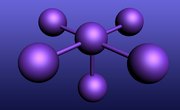
All matter contains atoms bonded together to form molecules. Three subatomic particles—electrons, protons and neutrons-—form these atoms. The ratio of positively charged protons to negatively charged electrons determines whether an atom is charged or uncharged.
Atomic Structure
Uncharged atoms generally contain a nucleus comprising protons and neutrons, surrounded by a cloud of electrons. The protons' positive charge attracts the negative electrons, holding them in orbit.
Atomic Mass
Atomic mass refers to the weight of the nucleus, which is roughly 1,800 times greater than that of the electrons. To calculate atomic mass, you simply add the number of protons and neutrons. Carbon atoms, for example, possess six protons and six neutrons, giving them an atomic mass of 12.
Atomic Number
The atomic number represents the number of protons in an atom's nucleus. In an uncharged atom, the number of protons is always equal to the number of electrons. For example, carbon atoms include six protons and six electrons, so carbon's atomic number is 6.
The Atom's Charge
The proton's positive charge attracts negatively charged electrons. Although this charge is strong enough to attract extra electrons from other atoms, it is also weak enough to lose electrons to other atoms.
As long as the number of protons in an atom equals the number of electrons, the atom remains uncharged, or neutral. When an atom gains or loses electrons, it becomes an electrically charged ion. An atom that gains electrons becomes a negatively charged anion. An atom that loses electrons becomes a positively charged cation.
References
About the Author
Joan Whetzel has been writing professionally since 1998. She has written juvenile nonfiction, movie and television scripts and adult nonfiction. Her juvenile nonfiction has appeared in such magazines as "Tech Directions," "Connect" and "Class Act." She was part of the production team that produced the documentary "Fuel for Thought" on Houston PBS. She has also written articles for Katy Magazine Online.
Photo Credits
atom image by Oleg Verbitsky from Fotolia.com
